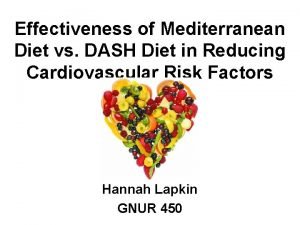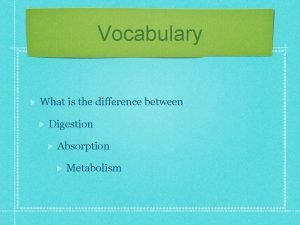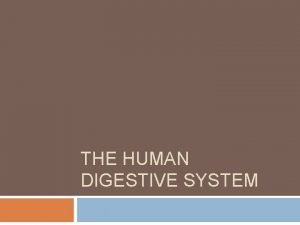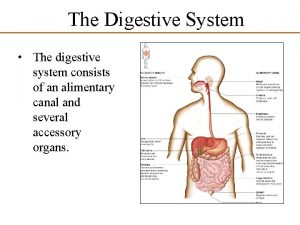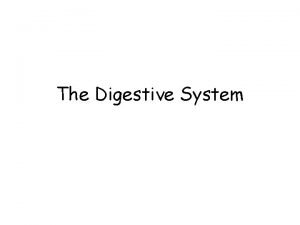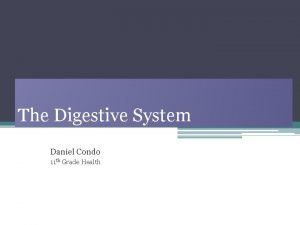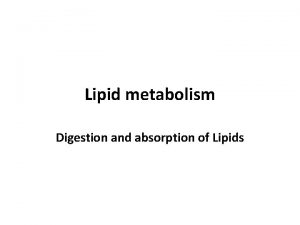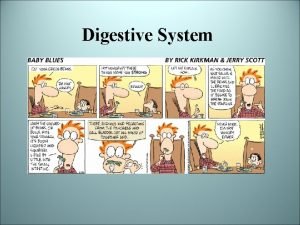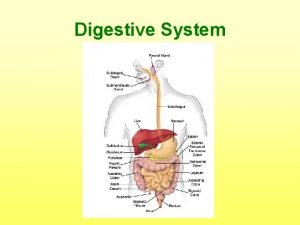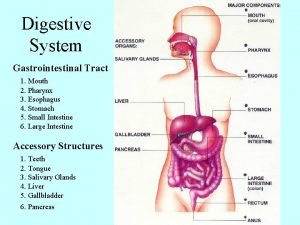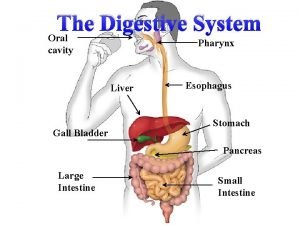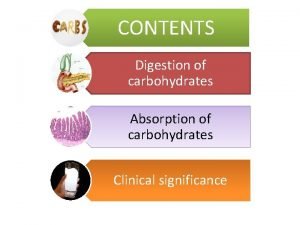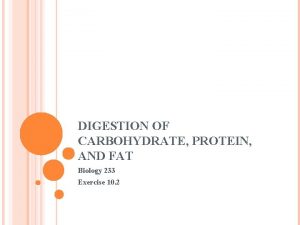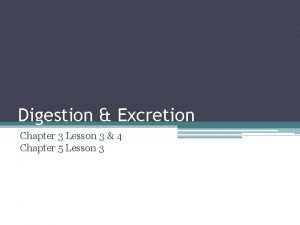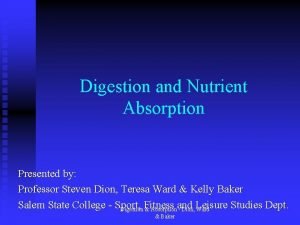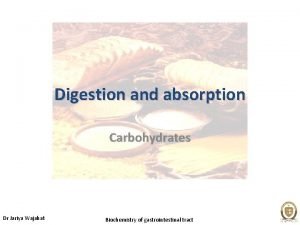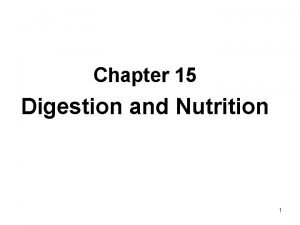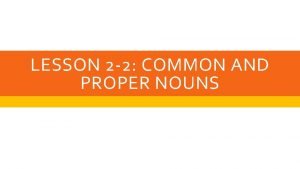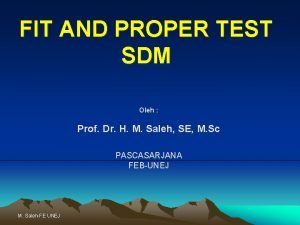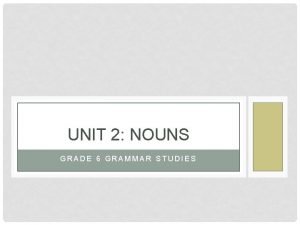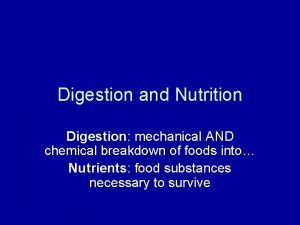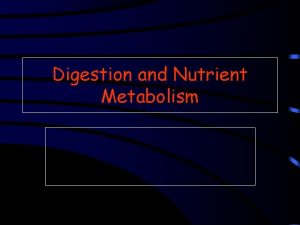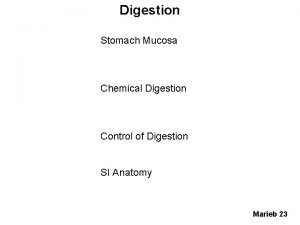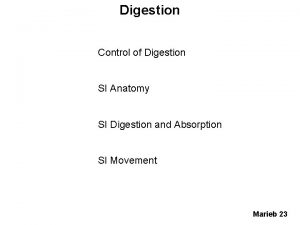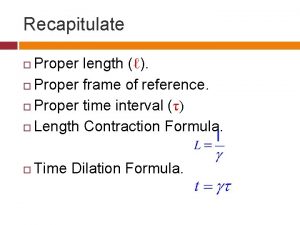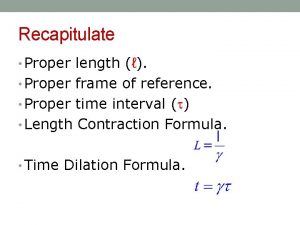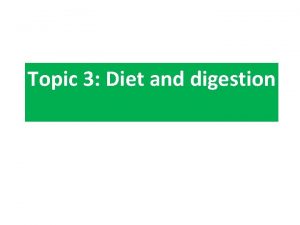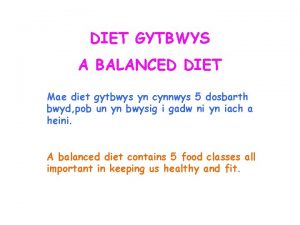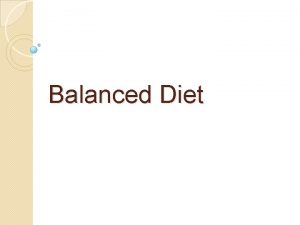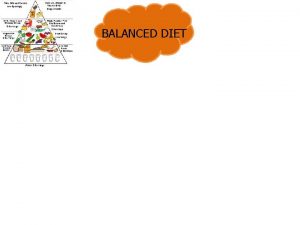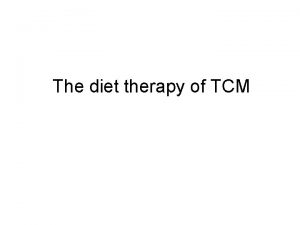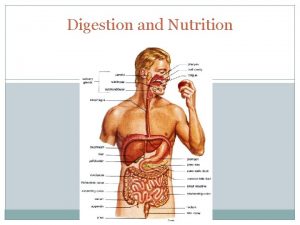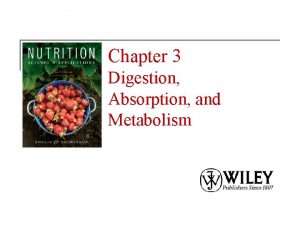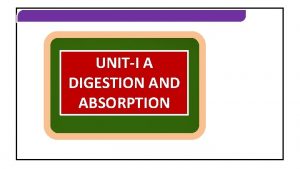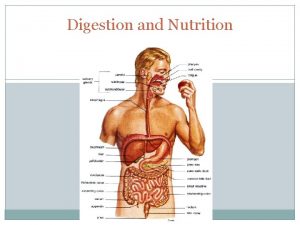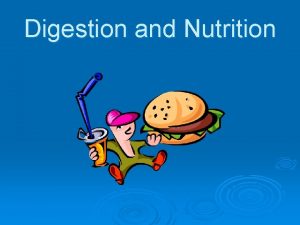Diet and Digestion Without proper diet medicine is
















































- Slides: 48

Diet and Digestion

“Without proper diet, medicine is of no use. With proper diet, medicine is of no need. ” Traditional Ayurvedic aphorism

Nutrigenomics • The field of nutrigenomics studies how food or nutrients can influence the expression of genes in the body. • Here we see a scientific verification of the ancient Ayurvedic principle that food is medicine

Dietary Risk Factors for Chronic Disease Modern and Ayurveda: – Junk foods, fast foods – Highly processed/refined foods – Empty calories – Poor quality oils, saturated fats, trans-fats Ayurveda: – Difficult-to-digest foods – Diet inconsistent with individual’s dosha type or imbalances

Personalization of Diet • Ideally diet should be personalized according to the individual’s body constitution and imbalances • General dietary principles can be helpful for most people (see handout, “Healthy Meal Plan for All Imbalances”) • Individual food intolerances or sensitivities must be taken into account • Principle of “acquired suitability” (oka-satmya) must be respected: example, red meat

General Dietary Recommendations • Favor fresh foods, freshly prepared—avoid packaged/highly processed foods • Favor whole foods—avoid highly refined foods, e. g. , refined sugar and other refined CHOs • Avoid food preservatives, pesticides, additives, hormones, GMOs —favor organic if possible • Avoid cold foods and beverages • Take enough time to eat—avoid rushing meals • Avoid overeating/eating too-heavy foods • Favor lunch as the main meal of the day • Emphasize lacto-vegetarian food sources

Mind-Body Effects of Food • Sattvic food: supports positive mood, healing, longevity (e. g. , milk, ghee, honey, almonds, figs and dates, fresh yogurt, fresh sweet fruit, mung dahl, rice) • Rajasic food: supports activity, dynamism; overuse can cause agitation, irritability (e. g. , meat, fish, pungent spices) • Tamasic food: promotes drowsiness, depression, low-energy (e. g. , leftovers, packaged/processed foods, fermented foods)

Foods for All Body Types (1) • Legumes: especially small beans, lentil-family: split mung dahl; mung beans; red, brown, and green lentils; split peas; chick peas; black beans • Nuts and seeds: almonds, walnuts, and pecans are most sattvic; peanuts are tamasic and should be avoided. Nuts are heavy to digest (best to soak, roast, or boil before eating). • Whole grains: whole wheat and rice are better for Vata and Pitta types; “light grains” are better for Kapha types (barley, millet, quinoa, buckwheat, oats, rye, bulgur wheat)

Foods for All Body Types (2) • Milk (cow’s): very sattvic but has a “cold” internal property (virya); always boil before taking, never take cold. See hand-out, “About Milk. ” • Goat milk is an alternative for Kapha. • Yogurt: freshest is preferred, homemade is best. Heavy to digest. Lassi (diluted yogurt drink) is more digestible. See hand-out, “Lassi Recipes”

Foods for All Body Types (3) • Cheese: heavy to digest; only consume if digestion is good and then only at lunch. Avoid/reduce aged cheeses (“hard cheeses”). Favor non-aged cheeses (“sweet cheeses”) such as cottage cheese, ricotta, mozzarella, paneer. • Oils: essential lubrication for body tissues, antioxidant, anti-inflammatory. Ghee is favored in small to moderate amounts, if no cholesterol problem. Olive oil is universally good. Other good choices: sunflower, sesame (safflower not as sattvic, peanut is tamasic).

Foods for All Body Types (4) Vegetables: • Best taken steamed or sauteed • Raw vegetables are difficult to digest: only take if digestion is good and only at lunch; add oil, Vata spice mix • Green vegetables are favored • Root vegetables should be minimized due to tamasic quality, including potato, yams, turnips, radish (exceptions: carrots, beets)

Foods for All Body Types (5) Fruit: • Fresh fruit should be taken away from other foods, such as a between meal snack • Dried fruits may be taken with other food, especially breakfast cereal (raisins, dates, figs) • Stewed fruit is very digestible and sattvic; it may be taken with breakfast or other meals or as a snack (apple, pear, raisins, figs, dates, apricots, etc. )

Foods for All Body Types (6) Honey: • Very sattvic; has medicinal properties • Is kapha-reducing and detoxifying in small amounts • Best taken at breakfast (Kapha time of day) • Use only raw, unheated honey (heated honey is considered toxic)

Foods for All Body Types (7) Spices: • Natural medicinals that aid digestion and metabolism; they are abundant in phytonutrients • They are documented to have numerous health benefits: antiinflammatory, anti-cancer, cardio-protective, anti-diabetes • A variety of spices should be included in the diet on a daily basis • Average American diet does not include sufficient amount or variety of spices • Premier spices: ginger, cumin, turmeric, coriander, fennel, cinnamon, black pepper, fenugreek, cardamom, mustard seeds, saffron, basil.

Research on Benefits of Spices Thousands of studies have been done--a few examples: • Ginger: called “the universal medicine” due to its digestionenhancing effect; also beneficial in arthritis, asthma, respiratory congestion, migraine, cardiovascular disease • Turmeric: potent anti-inflammatory, boosts immunity, antidiabetes, anti-cancer, Alzheimer’s protective, anti-cholesterol, anti-arthritis, anti-obesity • Cinnamon: anti-diabetes, anti-metabolic syndrome, protects brain cells after stroke • Fennel: anti-oxidant, colitis, BP, menstrual cramps, glaucoma, arthritis

Vata, Pitta, and Kapha Diets General Points • Vata: Favor warm cooked food, moderately spiced, with adequate oils. Avoid cold foods and drinks, dry foods, raw foods, insufficient quantity of food. • Pitta: Avoid highly spiced food, sour foods (acidic foods, aged/fermented foods), salty foods. Favor cooling foods (fresh sweet fruits, green vegetables), sweet dairy, cooling spices (fennel, coriander, cilantro, turmeric, mint, saffron, and small quantities of cumin, cinnamon, and fresh basil). • Kapha: Favor warm cooked food, lighter foods, less quantity of food; adequate spicing very important. Avoid heavy foods, oily foods, fried foods, cold foods and drinks.

Digestion: Foundation for Health Promotes breakdown and assimilation of nutrients • Produces energy • Builds and maintains bodily tissues and supports tissue-repair • Imbalanced digestion generates toxic impurities (Ama) which contribute to the pathogenesis of chronic disorders


Digestion: Key to Health or Disease Digestive Fire Proper Digestion Ojas Good Health Or Improper Digestion Ama Poor Health

Factors Disturbing Digestion and Causing Ama Overeating Eating while digesting previous meal Eating during indigestion Irregular eating Intake of too heavy, cold, rough, or unsuitable foods, including stale or processed foods, leftovers • Diet not consistent with constitutional type or dosha imbalances • Inadequate adaptation to time, place, or season • • •

Signs and Symptoms of Ama. Product of Incomplete Digestion • Diminished strength and stamina • Mental and physical fatigue • Heaviness in the body • Lack of mental clarity (“brain fog”) • Chronic congestion • Reduced immunity, • • • e. g. , frequent colds Frequent indigestion Constipation Repeated spitting Lack of taste for food Coating of tongue

General Health Survey: Ama Questionnaire

PROMOTING GOOD DIGESTION How we eat is as important as what we eat. Eating with full attention in a settled environment enhances the assimilation of the intelligence from the food.

General Principles of Digestion (1) • Eat in a quiet, settled atmosphere with settled mind. • Eat to about ¾ of capacity; satisfied but not feeling “full” • Avoid eating before the previous meal is digested (3 to 6 hours between meals) • Avoid cold foods and drinks

General Principles of Digestion (2) • Lunch should be the main meal of the day • Take a few minutes to sit quietly after eating • Do not eat right before going to bed. Warm, boiled milk is all right. • Chew well; digestion begins in the mouth. • Avoid large amounts of raw food, such as raw vegetables. Naturally grown, ripened fruits are fine.

General Principles of Digestion (3) • Eat as low down on the food chain as possible. Lacto-vegetarian diet is preferable. Poultry and fish are better than red meats (better to have them at lunch than supper). • Respect the principle of acquired suitability (Oka-satmya) • Avoid processed, packaged food • Favor organically grown food • Avoid genetically modified food

Proper Food Preparation • Food prepared in a pleasant environment by a happy cook is best. • Food should always be delicious and pleasing to the senses. • Food is best if warm and well-cooked. Cook slowly (similar to an open fire); avoid microwaving. • Food should always be fresh and of best quality. Avoid leftovers, reheated, frozen or processed food.

Strategies for Removing Ama • Lighter diet, quality and quantity (temporarily) • Spices according to body type • Sip hot water frequently during the day (if Pitta symptoms, sip warm water): see handout, “Hot Water Recommendation” • Lemon-honey water first thing in the morning • Periodic liquid or semi-solid diet (once every 1 to 4 weeks)

LIFESTYLE MEDICINE Promoting health through behavior in harmony with Nature and Nature’s cycles

Chronobiology is a relatively new field of study which describes the effects of time on living systems, particularly the effect of biological rhythms on health and treatment. Chronobiology supports the Ayurvedic concepts of dosha cycles and daily and seasonal health routines.

Daily Cycle of Vata, Pitta, and Kapha

Daily Cycle of the Doshas • Daytime: – Kapha period: 6 a. m. to 10 a. m. – Pitta period: 10 a. m. to 2 p. m. – Vata period: 2 p. m. to 6 p. m. • Nighttime: – Kapha period: 6 p. m. to 10 p. m. – Pitta period: 10 p. m. to 2 a. m. – Vata period: 2 a. m. to 6 a. m.

Seasonal Cycle of the Doshas • Kapha season: Springtime, around late March to late-June • Pitta season: Summer and early Autumn, around late June to late September/early October • Vata season: late Autumn through Winter, around late October to early March

Lifestyle Medicine: Key Points (1) Daily Routine: Maintain a regular routine Regular mealtimes Regular bedtime and arising time Regular bowel movements, morning preferred • Early bedtime (10 p. m. is best) and arising time (by 6 a. m. if possible) • Make lunch the main meal; supper lighter. • Daily routine: include meditation, exercise (e. g. , morning brisk walk), yoga asanas • •

Lifestyle Medicine: Key Points (2) Seasonal modifications in diet and routine depending on the dosha season: • Kapha season: lighter, drier diet; increase spices (Kapha spices); warm foods and drinks; more vigorous exercise • Pitta season: moderate food intake, cooling foods and drinks (not cold), cooling spices (Pitta spices); moderate exercise • Vata season: heavier food intake (depending on digestive power); moderate spices (Vata spices); warm foods and drinks; adequate oils; moderate to vigorous exercise depending on body type

Bowel Regularity • Adequate fiber • Adequate oils: olive oil / ghee (if no cholesterol problem) • Adequate fluid intake • Adequate exercise, yoga • Probiotics: lassi, yogurt, kefir • Herbal preparation: Triphala 1 -2 grams at bedtime • Upon arising, drink 1 -2 glasses of lukewarm water • Give it time, every day in the early morning

MIND-BODY BALANCE: Transcendental Meditation® (TM® ) technique

Mind-Body Approach: Transcendental Meditation • Direct contact with the least excited state of awareness (Atma) is the most powerful means of promoting health. • Charaka Samhita: “Complete transcending (of mental activity) is the best among the sources of health and happiness. ”

Transcendental Meditation • Simple, effortless practice • No concentration or contemplation • Maintained in its purity through the ageold tradition of Vedic masters • Scientifically validated: – Over 300 published peer-reviewed research studies – NIH grant support: over $24 million


Research results have documented a wide range of health benefits-1 • • Improved memory and cognitive function Reduced stress and anxiety Reduced depression Reduced cardiovascular risk factors Significant reduction in high blood pressure Reduced cholesterol Reversal of atherosclerosis

Research results have documented a wide range of health benefits-2 • Decreased blood sugar and insulin resistance • Improved heart health: decreased incidence of heart attack, stroke, and death in heart patients • Reduced health damaging behaviors (alcohol, cigarettes, drug abuse) • Increased longevity • Reduced hospitalization rates and medical care utilization

Trait Anxiety: Meta-Analysis of 143 Studies Reference: Eppley K, Abrams A, Shear J. Differential effects of relaxation techniques on trait anxiety: a meta-analysis. Journal of Clinical Psychology 1989 45(6): 957 -974

This meta-analysis of 107 published studies on stress reduction and blood pressure found that only the Transcendental Meditation program had a statistically significant impact of reudcing high blood pressure among hypertensive subjects. Reference: Current Hypertension Reports 9: 520 -528, 2007.

Schneider R, Nidich S, Kotchen J, Kotchen T, Grim C, Rainforth M, Gaylord- King C, Salerno J. Effects of Stress Reduction on Clinical Events in African Americans with Coronary Heart Disease: A Randomized Controlled Trial. Circulation. 2009; 120: S 461

Learn More Visit www. integrative-ayurveda. org to learn more about courses for: – Licensed Health Professionals (Physicians, Nurses, Acupuncturists, Social Workers etc) – Non-Licensed Health Professionals (Yoga Teachers, Health Coaches, Ayurveda Practitioners etc) – Personal Wellness

For more information on Ayurveda training courses: • Website: www. integrative-ayurveda. org • Email: info@ayurveda-courses. org • Phone: (877) 540 -6222 For information on Transcendental Meditation: • Visit: www. tm. org • Call: (888) LEARN-TM

Ayurveda Products VPK by Maharishi Ayur. Veda For Special 10% Product Discount for first-time purchase at VPK by Maharishi Ayur. Veda order by phone and use discount code: PWC
 Mechanical and chemical digestion venn diagram
Mechanical and chemical digestion venn diagram Proper words in proper places
Proper words in proper places Dash vs mediterranean diet
Dash vs mediterranean diet For my father who lived without ceremony
For my father who lived without ceremony Without a title poem
Without a title poem Alliteration in keeping quiet
Alliteration in keeping quiet Difference between digestion and metabolism
Difference between digestion and metabolism Bolus digestion
Bolus digestion Chemical and mechanical digestion
Chemical and mechanical digestion Peristalsis vs segmentation
Peristalsis vs segmentation Ingestion and digestion
Ingestion and digestion Digestive system function quiz
Digestive system function quiz Are lipids digested in the stomach
Are lipids digested in the stomach Haustra of colon
Haustra of colon Chemical and mechanical digestion
Chemical and mechanical digestion Digestion begins in the when you chew and swallow
Digestion begins in the when you chew and swallow Physiology of small intestine
Physiology of small intestine Vitamin c digestion and absorption
Vitamin c digestion and absorption Pharynx in digestive system
Pharynx in digestive system Difference of mechanical and chemical digestion
Difference of mechanical and chemical digestion How are carbohydrates digested
How are carbohydrates digested Lipid digestion and absorption
Lipid digestion and absorption Carbohydrate digestion and metabolism
Carbohydrate digestion and metabolism Digestion and absorption of carbohydrates
Digestion and absorption of carbohydrates Protein absorption
Protein absorption Illustration of the steps in restriction digestion and pcr
Illustration of the steps in restriction digestion and pcr Lesson 11 feeding and digestion
Lesson 11 feeding and digestion Lesson 11 feeding and digestion
Lesson 11 feeding and digestion Restriction ends
Restriction ends Enzyme carbohydrate
Enzyme carbohydrate Digestion and excretion lesson 3
Digestion and excretion lesson 3 Digestion and absorption
Digestion and absorption Lactose intolerant symptoms
Lactose intolerant symptoms Chapter 15 digestion and nutrition
Chapter 15 digestion and nutrition Is govenor capitalized
Is govenor capitalized Abstract noun with singular verb
Abstract noun with singular verb Common noun to proper noun
Common noun to proper noun Contoh presentasi fit and proper test
Contoh presentasi fit and proper test Which is the following true
Which is the following true Paragraph on noun
Paragraph on noun The proper distinction between law and gospel
The proper distinction between law and gospel Expressed powers cartoon
Expressed powers cartoon Proper handling and use of a microscope
Proper handling and use of a microscope Label the body parts with the proper adjective
Label the body parts with the proper adjective Is cereal a common noun or proper noun
Is cereal a common noun or proper noun Implied powers cartoon
Implied powers cartoon Common noun and proper noun project
Common noun and proper noun project Ladder raising and proper climbing angle
Ladder raising and proper climbing angle Nouns grade 6
Nouns grade 6


